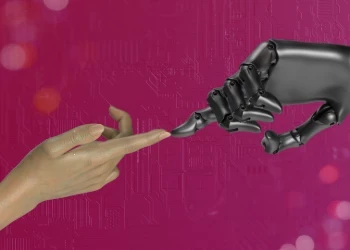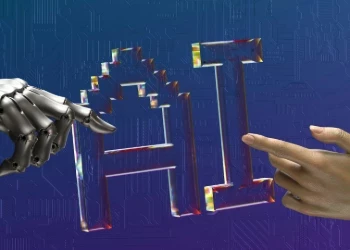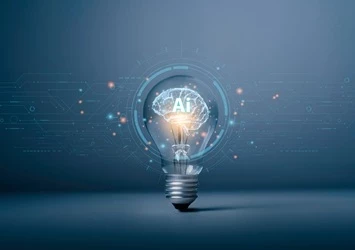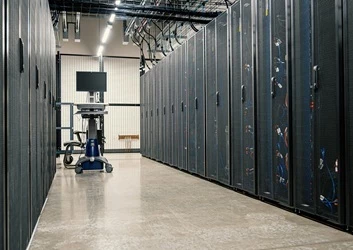
What is quantum computing?
Quantum computing is an area of study that explores how the properties of quantum physics can be used to store data and perform computations. Unlike traditional digital computers which use binary - the digits 0 and 1 - to perform these tasks, quantum computers perform calculations based on the probability of an object's state before it is measured. As a result, quantum computers have the potential to process exponentially more data and perform significantly more complex calculations compared to classical computers.
However, most computer scientists agree, quantum computers will likely provide no additional advantages over classical computers in terms of computability. That is to say, a classical computer could technically perform the same calculations as a quantum computer, but, given the immense time and compute power necessary to do so, it’s simply impractical.
Though quantum computing may eventually achieve superiority when it comes to performing complex calculations, that doesn’t mean it will surpass classical computing when it comes to simple, daily computing tasks such as running desktop apps, email and so on. In fact, at this point, it may be best to approach quantum computing as a separate, complementary device instead of a full-blown replacement for traditional computers.
Though most experts estimate we’re at least 20 years away from quantum computing going mainstream, we could see the unveiling of the first commercial quantum computer by 2030. This is significant because, as we get into later in this piece, the second the first quantum computer is released into the market it could, potentially, render a number of critical technologies - such as cryptography and blockchain - obsolete. In other words, current cybersecurity methods will be obliterated.
In addition, the individual scientific breakthroughs that have resulted from QC research have the potential to not only shape the future of computing, but expand our understanding of quantum mechanics and the very nature of our universe.
 *Image sourced from https://www.ibm.com/quantum-computing/
*Image sourced from https://www.ibm.com/quantum-computing/
How does quantum computing work?
There are several types of quantum computers in various stages of development including the quantum Turing machine, adiabatic quantum computer, one-way quantum computer, and quantum cellular automata. The most widely used model, and the one we’ll be focusing on, is the quantum circuit model.
Instead of binary code, quantum circuit computing systems use qubits, computing units that can be on, off or any value between, to make calculations. Qubits use quantum mechanical phenomena like superposition and entanglement to exist in multiple states at the same time until measured and to hold up to two bits worth of data.
To elaborate, while today’s computers use eight bits to represent any number between 0 and 255, a quantum computer can use eight qubits to represent every number between 0 and 255, simultaneously. This ability, at least in theory, enables quantum computing systems to make calculations and process data many times faster than traditional computers.
The quantum mechanical properties harnessed by quantum computing are notoriously difficult to study. The truth is no one, not even theoretical physicists, truly understand how quantum mechanics works, they simply know how to use the principles of quantum mechanics with “perfect confidence.”
In quantum computing, qubits are manipulated and managed using qubit control devices. For example:
- Ion traps use optical or magnetic fields (or a combination of both) to trap ions
- Optical traps use light waves to trap and control particles
- Quantum dots are made of semiconductor material and are used to contain and manipulate electrons
- Semiconductor impurities contain electrons by using "unwanted" atoms found in semiconductor material
- Superconducting circuits allow electrons to flow with almost no resistance at very low temperatures

*Image of Google's Sycamore processor sourced from https://quantumai.google/
When it comes to hardware, most quantum computing systems consist of 5 components:
- Quantum data plane. The core hardware of QC, this is where the qubits physically reside.
- Control and measurement plane. Completes tasks on the qubit models with the necessary constraints
- Control processor plane. Converts compiled code to commands for the control and measurement layer.
- Quantum module Interconnect (QuICs). Devices or processes that allow the transfer of quantum states between two specified physical degrees of freedom (material, electromagnetic, etc.), or, more broadly, connect a quantum system with a classical one.
- Host processor. A classical computer that handles access to networks, large storage arrays, and user interfaces.
When people talk about quantum computing, they often mention 3 types of subatomic phenomenon that power these systems which we have listed below. Please note, these are incredibly complex scientific concepts and the definitions below are vastly oversimplified.
- Superposition - the ability of a quantum system to be in multiple states at the same time until it is measured. The thought experiment known as “Schrödinger's Cat” is often used to illustrate this concept both in academic settings and in popular culture.
- Entanglement - A physical relationship between two or more qubits in which one qubit seems to know what happens to another, even when they are a large distance apart.
- Quantum Tunneling - A teleportation phenomenon whereby particles pass through seemingly unbreakable energy barriers. Enables parallel calculations, thereby potentially reducing power consumption by 100 - 1000 times.
What is a quantum algorithm?
A quantum algorithm is any algorithm that can be executed on a quantum computer. Quantum algorithm algorithms are similar to classical computing algorithms except for one key difference: at least one of the steps must be distinctly “quantum” (i.e. using superposition or entanglement).
There are various quantum algorithms in existence including:
- Fourier transform-based quantum algorithms
- Amplitude amplification-based quantum algorithms
- Quantum walks based algorithm
- BQP-complete problems
- Hybrid quantum/classical algorithms
The Advantages of Quantum Computing
As mentioned previously, the number one potential advantage of quantum computing is speed. For example, Google claims its quantum computer, which is still in development, performs roughly 158 million times faster than the world’s fastest supercomputer. In other words, it was able to perform a calculation so complex that it would take the world’s most powerful supercomputer, IBM’s Summit, 10,000 years to perform in just 200 seconds.
As qubits can work it parallel, quantum computers are significantly more energy efficient than classical methods when it comes to processing data. In fact, while modern classical supercomputers, on average, use between 1-10 megawatts of power, most quantum computers require only 25 kilowatts, most of which goes towards refrigeration. In the future, as the technology evolves, it could require even less energy.
Though it’s impossible to say with 100% certainty how quantum computers will be used, it’s generally proposed that they will significantly outperform traditional methods in these 4 areas:
- Optimization. Think traditional optimization algorithms, which analyze large data sets to identify the best solution or process among multiple feasible options, on steroids. Supply chain logistics, manufacturing operations and route planning are just some of the areas where QC could deliver transformational results. For example, Volkswagen used quantum computers to optimize traffic flows during a large multi-day conference in Lisbon.
- Searching through high volumes of unstructured data (i.e. Grover’s algorithm).
- Simulation. A digital twin is, in essence, a computer program that uses real world data to create simulations that can predict how a product or process will perform. It is possible that not only will quantum computers be able to build digital twins faster and more efficiently than traditional methods, but will also enable the modelling of significantly larger, more complex systems. For example, a quantum computer may be able to better simulate molecular behavior, enabling pharmaceutical companies to develop and test drugs faster as well as more effectively.
- Cryptography. The mathematical operations that most traditional cryptographic algorithms rely on could be easily cracked with a sufficiently strong quantum computer. Quantum cryptography uses the principles of quantum mechanics to encrypt data and transmit it in a way that cannot be hacked by a quantum computer.
- Artificial Intelligence and Machine Learning. Though whether or not QC could lead to general AI (i.e. “smarter” AI algorithms) is still a matter of debate, at the very least QC could boost AI performance in terms of speed and efficiency. In fact, IBM claims to have found “mathematical proof” of a quantum advantage for quantum machine learning, though there are numerous caveats to these findings.

*Image sourced from A business leader’s guide to quantum technology
Disadvantages of Quantum Computing
Quantum computers are often purported to be the magic solution to everything from climate change to cancer. Though applications of quantum computings to these areas may result in new innovative solutions, as the technology is still theoretical, no one can really say definitively what quantum computer can and/or should be used for.
Professor and Director of the University of Texas Austin’s Quantum Information Center, Scott Aaronson has written extensively on the dichotomy between the potential promise of quantum computing and its current limitations. Not only is it entirely possible that quantum computing may only be suitable for very narrow use cases, at the rate of current development, it’s feasible that classical computing methods might simply evolve past those of quantum computing.
And he’s not alone. Michel Dyakonov, a theoretical physicist at the University of Montpellier, and Subhash Kak, Regents Professor of Electrical and Computer Engineering at Oklahoma State University, have written also written extensively on the major technological barriers that stand in the way of the creation of a “practical” quantum supercomputer.
As of now, current quantum computers remain exceedingly difficult (as well as expensive) to engineer, build and program. They are also highly sensitive; even minor disturbances like temperature fluctuations and dust can trigger a process known as decoherence whereby particles, such as qubits, lose their quantum properties. This causes the system to produce errors and/or crash entirely.
Recent Quantum Computing Breakthroughs
Despite the significant engineering challenges that stand in the way, many companies are going full steam ahead with quantum computing. Considering the industry could eventually grow to $1 trillion, it’s hard to blame them. Here’s a short list of some recent quantum computing breakthroughs to give you a better feel for where the technology currently stands, could be heading and who the key players are.
IBM
A longtime pioneer of quantum computing, in November 2021, IBM announced it had created a new quantum processor, dubbed the “Eagle,” designed to contain more than 100 operational and connected qubits. It follows IBM’s 65-qubit ‘Hummingbird’ processor unveiled in 2020 and the 27-qubit ‘Falcon’ processor unveiled in 2019. The company also plans to release the first 1000-qubit quantum computer in 2023.
In order to advance quantum research, IBM launched its Quantum Network in 2017. Described as “a community of Fortune 500 companies, academic institutions, startups and national research labs working with IBM to advance quantum computing,” IBM’s QN provides 170+ partnership organizations with access to its quantum technology.
LG, Daimler, Boeing and Goldman Sachs have already joined the network and are in the process of developing practical use cases for quantum computing.
Alphabet/Google
Researchers at Google in collaboration with physicists at Stanford, Princeton and other universities claim they have used Google’s quantum computer to create a new phase of matter known as a “time crystal.” According to them, a time crystal is an object whose parts move in a regular, repeating cycle, sustaining this constant change without burning any energy. In other words, they evade the second law of thermodynamics.
Though it’s unclear whether or not time crystals will have practical use, this breakthrough has, reportedly, given Alphabet the confidence to spin out its quantum company into a separate business.
IonQ
In August 2021, IonQ, the first quantum startup to go public, unveiled its Reconfigurable Multicore Quantum Architecture (RMQA). As the company explained on their website, “starting with the demonstration of 4 chains of 16 ions each that can be dynamically configured into quantum computing cores, IonQ believes it has laid the foundation for increases to qubit count into the triple digits on a single chip, as well as future Parallel Multicore Quantum Processing Units.”
In October, IonQ, in partnership the University of Maryland, Georgia Tech and Duke University published a study that demonstrated how trapped ion systems like IonQ’s can soon deploy fault-tolerant logical qubits to overcome the problem of error correction at scale, a massive obstacle to large scale quantum computing.
Quantinuum
In 20201, Honeywell Quantum Solutions and Cambridge Quantum were able to achieve a quantum volume of 1,024 while demonstrating real-time error correction, to a breakthrough algorithm that enables quantum machines to do more significant calculations with fewer qubits. Following this success, in November of 2021, the two companies announced they would be merging to create a new firm called Quantinuum.

































